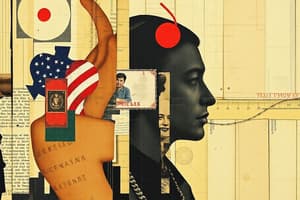Podcast
Questions and Answers
A common misunderstanding is referred to as a ______.
A common misunderstanding is referred to as a ______.
misconception
The term ______ describes the difficulty in communication due to different languages.
The term ______ describes the difficulty in communication due to different languages.
language barrier
Being ______ means being open to new ideas and perspectives.
Being ______ means being open to new ideas and perspectives.
open-minded
A person who is ______ may lack consideration for others' feelings.
A person who is ______ may lack consideration for others' feelings.
To successfully adapt to a new environment, one must ______ to the changes around them.
To successfully adapt to a new environment, one must ______ to the changes around them.
La unión entre los reinos de Castilla y Aragón es una unión ______.
La unión entre los reinos de Castilla y Aragón es una unión ______.
Isabel tenía en exclusiva los derechos ______ en Castilla.
Isabel tenía en exclusiva los derechos ______ en Castilla.
Fernando podía ostentar el título de rey en ______.
Fernando podía ostentar el título de rey en ______.
La muerte de Isabel en 1504 puso en riesgo la ______ de la unión de ambas Coronas.
La muerte de Isabel en 1504 puso en riesgo la ______ de la unión de ambas Coronas.
Los Reyes Católicos transformaron una monarquía feudal en una monarquía ______.
Los Reyes Católicos transformaron una monarquía feudal en una monarquía ______.
La justicia es impartida por los ______ en la primera instancia.
La justicia es impartida por los ______ en la primera instancia.
Se decreta la ______ de los judíos en 1492.
Se decreta la ______ de los judíos en 1492.
La ______ fue establecida en 1478 como un instrumento de control religioso.
La ______ fue establecida en 1478 como un instrumento de control religioso.
Flashcards are hidden until you start studying
Study Notes
Cross-Cultural Equivalents
- The document lists paired concepts to help with translation or cultural adaptation.
- Each pair includes a concept in one language and its corresponding concept in another language, likely Spanish.
- The table shows a list of equivalents for various concepts, including cultural differences, communication, social behavior, and perception.
- The concepts are listed in a table with two columns: “Concept (Likely English)” and “Equivalent (Likely Spanish)”.
- Due to handwriting style, the exact nature of the source language is uncertain.
- The specific terms also require context for a precise and absolute translation, therefore, the possible meaning and equivalents of the concept are written within the parenthesis.
The Dynastic Union of the Kingdoms of Castile and Aragon
- The union of Castile and Aragon in 1469 was a personal union, not an institutional union.
- This meant that both kingdoms had the same monarchs, but they retained their own separate institutions and laws.
- Although both monarchs could make political decisions, Isabel of Castile held the rights of succession.
- Fernando of Aragon was co-regent but Isabel had the right to rule and was the only one who could inherit the throne.
- The union of both kingdoms contributed to the formation of the Spanish Monarchy, also known as the Hispanic Monarchy.
- Castile was dominant within the Spanish Monarchy for various reasons, including size, population, and economic power.
The Formation of the Modern State
- The Catholic Monarchs (Isabel and Fernando) aimed to transform the traditional feudal monarchy into a modern, authoritarian one with centralized power.
- They implemented a series of reforms to strengthen the monarchy's authority, including:
- Reforming the justice system, strengthening royal authority.
- Establishing a hierarchy of courts:
- Corregidores: local courts in charge of first instance.
- Chancillerias or Audiencias: higher courts (Valladolid in the north and Granada in the south, established in 1505).
- The Royal Council: Highest court, serving as a supreme tribunal.
- Religion was used to unify the territory.
- The Catholic Monarchs saw Christianity as a fundamental basis for unity, excluding Jews and Muslims.
- This led to a series of initiatives against the two religious minorities:
- Expulsion of Jews: This occurred in 1492.
- Forced conversion of Muslims: These conversions were later enforced.
- The Spanish Inquisition: established in 1478 to investigate and persecute those suspected of heresy, especially "false converts" to Christianity (people who were suspected of continuing to practice their original religion in secret).
- The Spanish Inquisition operated under the direct authority of the monarchs, serving as a tool for their authoritarian policies.
Studying That Suits You
Use AI to generate personalized quizzes and flashcards to suit your learning preferences.




